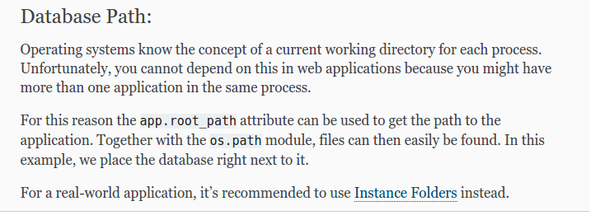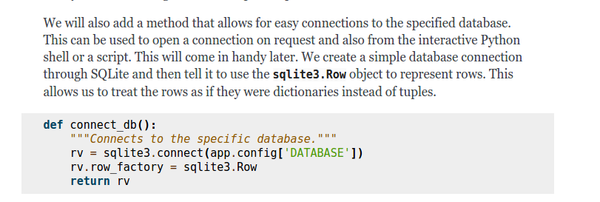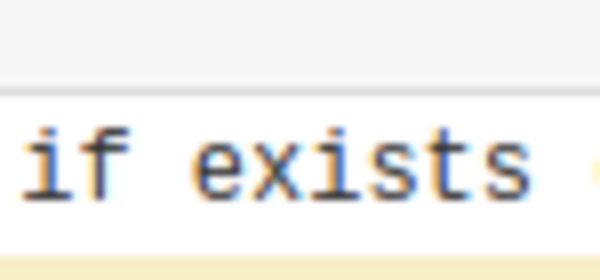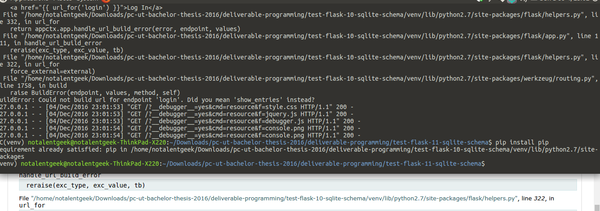
- There will be an AssertionError when the assert condition does not meet.
- This does not mean that the program is buggy/vaulty.

app.root_pathrefer to the root directory of the Python project.- This notion comes from Python's
os.pathmodule. So, I need toimport osat the start of the Python codes.

- It is a good idea to separate environmental settings and any other specific configuration files.
- Flask allows one to import these setting as a separate files later on if the settings is necessary.
- There is a method
from_envvar()that is used to enable robust configuration setup. However, I am not sure yet on how to use this. Perhaps this is useful for this project? I am not so sure.

- Ooo
from_envar()is a method to called your pre - made environmental variables. - From this example
app.config.from_envvar('FLASKR_SETTINGS', silent=true)means that this Flask web application will look intoFLASKR_SETTINGenvironment variable (in Linux,export FLASKR_SETTING=value_here) thesilent=truemeans that this application will not complain if the setting value is not provided.

- Basically there is this function to connect the Flask web application with database.
- This tutorial used SQLite3 for database. So I am not sure if the method to connecting to database is different to non - lite SQL.
- Here are the codes to connecting to database.
def connect_db():
rv = sqlite3.connect(app.config['DATABASE'])
rv.row_factory = sqlite3.Row
return rv
- There are little to no description on what this codes does.
- I think the
sqlite.connect()is for connecting to the database. - Then I suggest that its first argument is the database path which is located in
app.config['DATABASE']. - When assigning a variable into
sqlite3.connect()I assume it returns the database object itself. Hence, the variable now has access torow_factoryfield. - I am not sure on how the
sqlite3.Rowworks.

- There is a method in Flask of where you can assign new command to be executed in terminal.

- So here is the basic setup to run the Flask web application.
export FLASK_APP=main_entry_of_your_flask_application.py
export FLASK_DEBUG=1
flask run
- The first line is to determine the entry point of this Flask web application.
- The second line is to set Flask application in debug mode. Means that the application will not required to be stopped and then run again to see the changes made.



- Use
setinstead ofexportwhen using Windows. - Also never use debugging mode for a production system. Debugging mode will allow user to execute code in server.

- This was an example of the code working.
- There is nothing to display on
'/'because the route is not yet set.

- Transaction encapsulation, I am not sure on why on the ideal case there will be only one request at the time that uses the database connection.
- What happen in the real time application if there are multiple request at the same time?


- Flask provides application context and the request context.
- In NodeJS' ExpressJS there are request and response handler. But in Flask there are the application context and the request context.
- I am not so sure if these notion from NodeJS's ExpressJS works the same with Flask.

- There is this
flask.gobject that can be used to store settings across sessions.


- There is a
teardown_appcontext()decorator that will execute codes when the the application is closed in the client side. It says in this tutorial thatteardown_appcontext()will be executed when a request finishes.- When everything went well (the error parameter will be
None) - An exception happened.
- When everything went well (the error parameter will be
- This is useful to disconnect the connection to the database.

- I am not sure why it is necessary to put all of these methods after
connect_db()function.

- It is only says that this is logical to put methods for same module together.
- So, there would be no harm to put it alphabetically I guess.

- Flask is a database powered application.
- Hence, we need to create schema first for every database that we are going to make.

- Relational database is the SQL variants.
- Does this means that Flask is not intended to use with NoSQL databases like MongoDB?


- Basic command to create schema are as follows,
sqlite3 /tmp/flaskr.db < schema.sql. - However, the command needs to have
sqlite3CLI application to be installed. - There is a Flask way to generate database from schema.
- It is also good to have in application method to build and initialize database for the application itself.


- I had this problem.
- I thought the problem lies on my Python codes.
- But the problem actually is in my schema file.
- It is supposed to be
existsnoexist.


- The
sqlite3.Rowmakes the returned value looks like a Python's dictionary.

- When you can to refactor your project it is necessary to create new virtual environment.
- Delete the
venvfolder and initiatevirtualenv venvagain. - Because otherwise the path will stay in the old project's directory.

- You need to use question marks when building SQL statement.
- Otherwise the application will be vulnerable to SQL injection.
- Example codes.
db.execute(
'insert into entries (title, text) values (?, ?)',
[request.form['title'], request.form['text']]
)